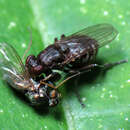fr
noms dans le fil d’Ariane


Ochthera ist eine Gattung aus der Familie der Salzfliegen (Ephydridae). Sie wurde von Latreille 1802 eingeführt.[1]
Die Fliegen sind meist 4–5 mm lang.[1] Ihre Facettenaugen liegen relativ weit auseinander. Die vorderen Coxae sind stark verlängert. Die vorderen Femora sind verdickt und weisen auf ihrer Unterseite Stacheln auf. Die vorderen Tibien weisen einen dornartigen Sporn auf, der ähnlich Fangschrecken nach hinten gerichtet ist.
Die Fliegen findet man an verschiedenen Gewässern (Tümpel, Bäche, Flüsse und Seen). Die Imagines erbeuten mit ihren kräftigen bewehrten Vorderbeinen kleinere Insekten, darunter Fliegen, Mücken und Spitzkopfzikaden und deren Larven.[1] Mit Hilfe ihres dornartigen Sporns können sie auch Beutetiere aus dem Boden ausgraben.[1] Die Larven entwickeln sich aquatisch oder semi-aquatisch.[1] Sie ernähren sich räuberisch, hauptsächlich von den Präimaginalstadien von Zuckmücken (Chironomidae).[1] Die Larven der in Afrika vorkommenden Art Ochthera chalybescens erbeuten auch die Larven und Puppen der Stechmücken-Art Anopheles gambiae, die als ein bedeutender Vektor für Malariaerreger gilt.[2]
Die Gattung besteht aus etwa 40 Arten weltweit.[1] In Europa ist Ochthera mit 4 Arten (O. manicata, O. mantis, O. palearctica, O. schembrii) vertreten,[3] in Nordamerika mit 13 Arten.[1]
Im Folgenden eine Auswahl der Arten:[4][3][5]
Ochthera ist eine Gattung aus der Familie der Salzfliegen (Ephydridae). Sie wurde von Latreille 1802 eingeführt.
Ochthera is a genus of flies in the family of shore flies (Ephydridae). The genus is distinctive because of the swollen raptorial forelegs. The larvae are predaceous on midge larvae while the adults feed on midges and mosquitoes. The genus is found around the world with about 37 species.[3] The species Ochthera chalybescens has been shown to prey on African malaria vectors .[4][5]
It has been noted that foreleg waving may be involved in displays and UV reflective patches on the face and fore coxae may be involved.[6]
Spreading and waving of the foreleg is involved in same sex encounters as well as with male and female pairs during approach. It is not known if it is a threat or a recognition display. Adult Ochthera mantis have been noted to probe sand with their proboscis and when they detect prey such as chirononomid larvae, they are excavated using the fore tibial spines and held between the tibia and femora as the prey is consumed.[7]
All species in the genus are predaceous.
These 55 species belong to the genus Ochthera:
 Ochthera mantis
Ochthera mantis Ochthera is a genus of flies in the family of shore flies (Ephydridae). The genus is distinctive because of the swollen raptorial forelegs. The larvae are predaceous on midge larvae while the adults feed on midges and mosquitoes. The genus is found around the world with about 37 species. The species Ochthera chalybescens has been shown to prey on African malaria vectors .